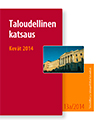Economic Survey, Spring 2014
The world economy has shown some encouraging signs of late, although growth is still fragile and the situation varies quite considerably for different regions. However the world economic situation remains precarious and more sensitive than usual to negative shocks. This applies most particularly to the euro area, where economic growth is still very modest and where even relatively minor negative factors can easily cut down the incipient growth. Over time the turnaround of the world economy will also lead to a rebounding of the domestic economy.
Finnish GDP is expected to post growth of no more than 0.5% in 2014. The forecast includes the assumption of an economic turnaround, and the single biggest driver of economic growth is foreign trade. Private consumption will show no growth in 2014 because of the slow growth of real purchasing power, the subdued future outlook and the situation in the labour market. Private investment will continue to fall, and the rate of private investment to GDP will fall back to 15.4%. The unemployment rate will continue to edge up and the forecast for the average unemployment rate in 2014 is 8.4%. Employment will also be down by 0.3% from the year before. Productivity, measured in the number of hours worked, will develop quite slowly.
In 2015 GDP growth will pick up to 1.4%. This growth will be increasingly broadly-based, with public investment being the only demand item having a negative growth effect. Private consumption will rise by close to ½% as a result of improving future expectations. This will also have the effect of reducing the household savings rate. It is noteworthy that the rising trend in household debt ratio is stabilising at 119% of disposable income. It is forecast that private investment will turn around to show growth of 4.6%: this trend will mainly be driven by investment in machinery and equipment and investment in construction. Public investment will continue to fall. The situation in the labour market will continue to remain weak, and despite the slight improvement in economic activity the unemployment rate is expected to remain roughly unchanged at this year’s level.
In 2016 economic growth is expected to reach 1.8%. The GDP growth rate will exceed potential output growth, despite the historically sluggish rate of economic growth. The level of total output will remain lower than potential output because of the underuse of economic resources. The economy’s growth potential is low due to demographic factors, sluggish investment and changes in the production structure.
Despite the recent positive trend in the global economy and the improved outlook in the domestic economy, the risks in the outlook are still predominantly to the downside.
The general government budgetary position has been in deficit for five years now, and the same situation will continue in years 2014-2016. Following the past two years of recession, the relatively sluggish rate of economic growth will not be enough to turn public finances into a surplus. Population ageing is also putting a major strain on public finances, reducing the number of people of working age and at once driving up age-related public expenditure. Public debt to GDP will continue to rise and is set to breach the 60% limit.
- Taloudellinen katsaus, kevät 2014
(03.04.2014)
- Ekonomisk översikt, våren 2014
(03.04.2014)

Economic Survey, Spring 2014
03.04.2014- Publications
- Ministry of Finance
- ISSN Web: 1797-9714
- ISBN Web: 978-952-251-557-5
Economic Prospects



